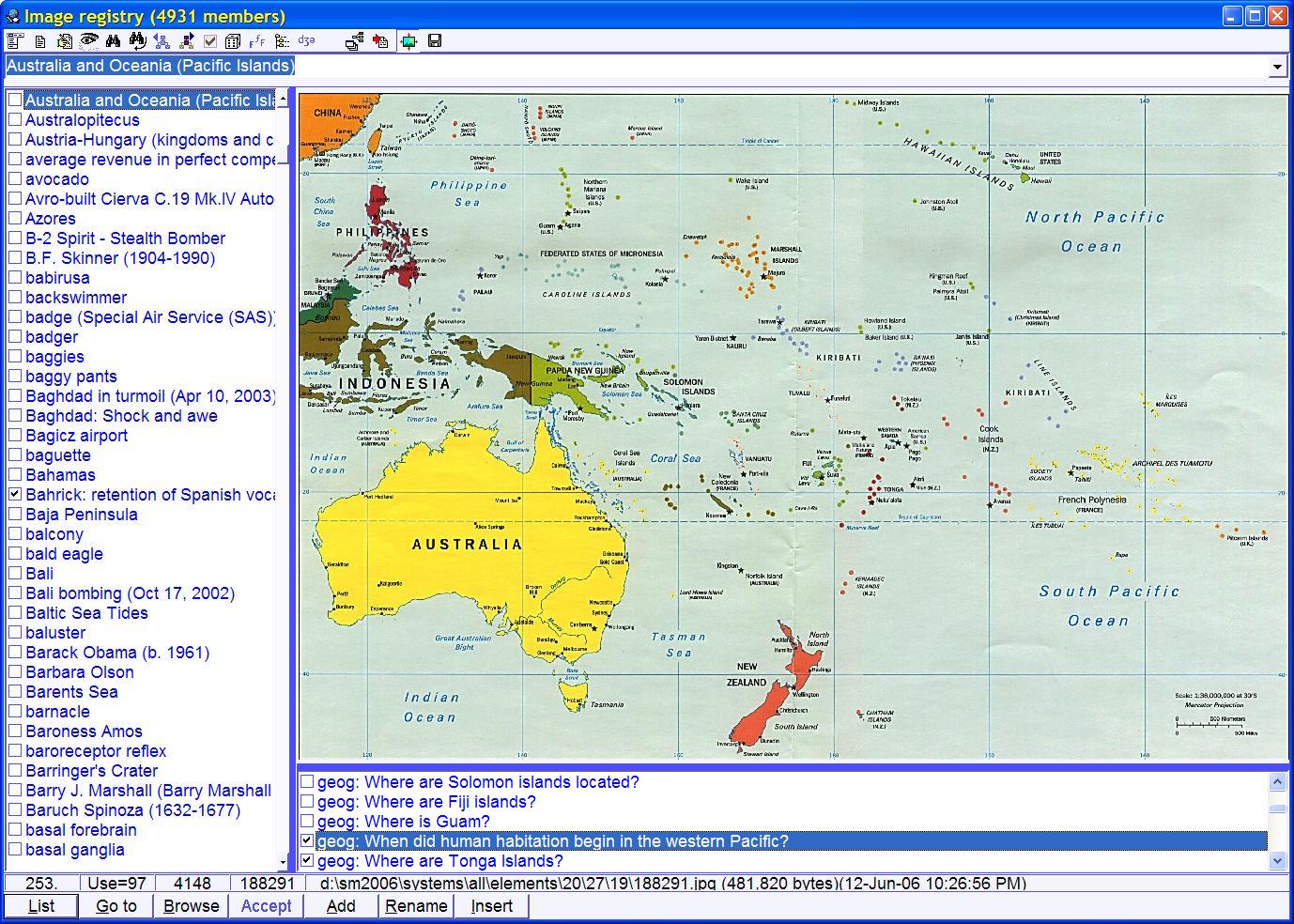Registries are sorted sets of objects used in SuperMemo such as texts, images, sounds, fonts, etc. By using registries, SuperMemo reduces the overall size of collections, and makes it easy to reuse objects already introduced into the current collection. For more information about registries see: Using registries
All existing registries can be accessed from the Search menu
A registry window is used to access individual members of a registry. The picture below shows the image registry window:

Here are the part of the registry window:
- caption - name of the registry and the total number of registry members. Here the image registry keeps 354 images
- registry toolbar (at the top) - buttons providing mouse shortcuts to the most often used registry options
- editing field (under the toolbar) - field used in incremental search, i.e. searching for members by typing in initial characters of their names. Here the search found rubber plant although the user have clicked on the shoulder join entry that has been selected and displayed in the display panel on the right
- list of member names (left side of the window) - alphabetically sorted list of names of individual registry members. Here the list displays images from the rubber plant to the terrapin. The scrollbar on the right shows the approximate position of these images on the alphabetical list
- object display field (top of the right side of the window) - field that is used to display the object that is currently selected in the list of members (on the left side). In some registries this field is empty (e.g. sound registry, program registry, etc.) or is divided into two parts (e.g. text registry displays text translations, lexical registry displays phonetic transcription of individual words, translation registry displays the original texts, etc.). Here the picture of the shoulder joint is presented
- element list (bottom of the right side) - upon clicking the button List at the bottom of the registry window, the element list is filled out with all elements that use a given registry member. If the number of elements that use the member is greater than the maximum number allowed by SuperMemo, only a subset of elements will be displayed. In the example above, the titles of several items on anatomy and medicine are shown. These items reuse the presented picture of the shoulder joint
- status bar (bottom of the window above editing buttons) - information about the currently selected member: registry index (i.e. the ordinal position of the registry member in the registry), number of elements that use the member, physical position in the registry, number of the filespace slot (if any), and path to the registry member file with the file size (if relevant). The filespace slot is a numbered position of a file in the elements folder. The first file will get the slot one, second slot two, etc. (e.g. 1.bmp, 2.htm, 3.wav, etc.). In the example above, the shoulder joint picture is alphabetically the 280th picture in the registry, it is reused by 11 elements, it is physically placed on position 43 in the registry, and it uses the filespace slot number 28591. The actual jpg file is located in the folder d:\colls\biology\elements\3\5\9\ and is named 28591.jpg (note that the name is derived from the filespace slot). The size of this file is 39.264 bytes
- editing buttons (bottom of the window):
- List - list the elements that use the currently selected registry member (the list is displayed in the element list at the bottom of the right side of the window)
- Go to - go to the first element using the currently selected registry member
- Browse - display all elements that use the currently selected registry member in an element browser. Note that the Browse button on the toolbar can be used to display all elements that use all registry members belonging to the current subset
- Accept - link the currently selected registry member with the requesting source (e.g. if you choose Links : Registry member on a sound component pop-up menu, the component will be linked with a sound object associated with the sound registry member selected at the moment of pressing Accept)
- Add - add a new registry member to the registry
- Rename - change the name of the currently selected registry member
- Delete - delete the currently selected registry member. Note that the associated registry object, e.g. sound file, font, etc. will also be deleted (unless it is stored on CD-ROM)
Professional level
Right click over the registry window opens the registry pop-up menu with advanced operations on the registry

